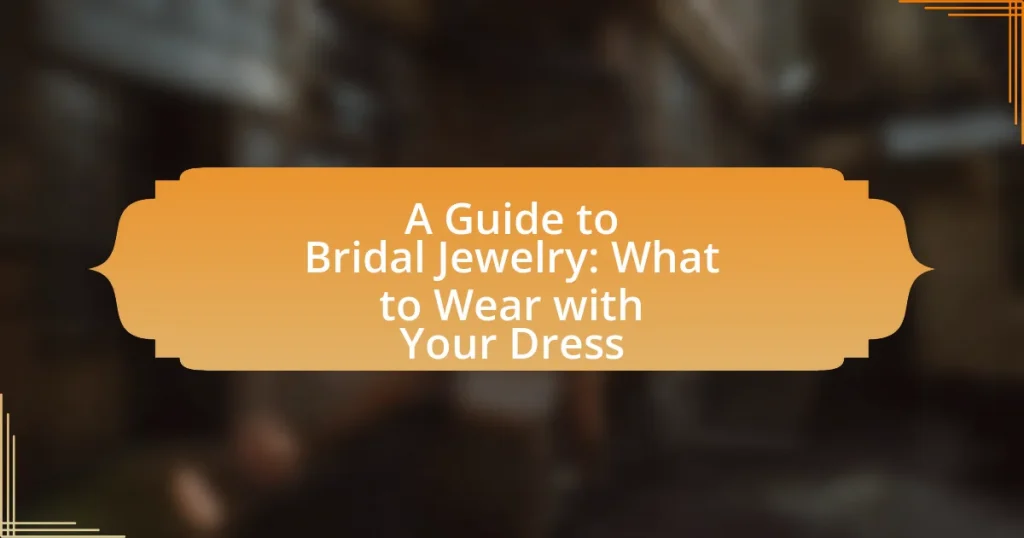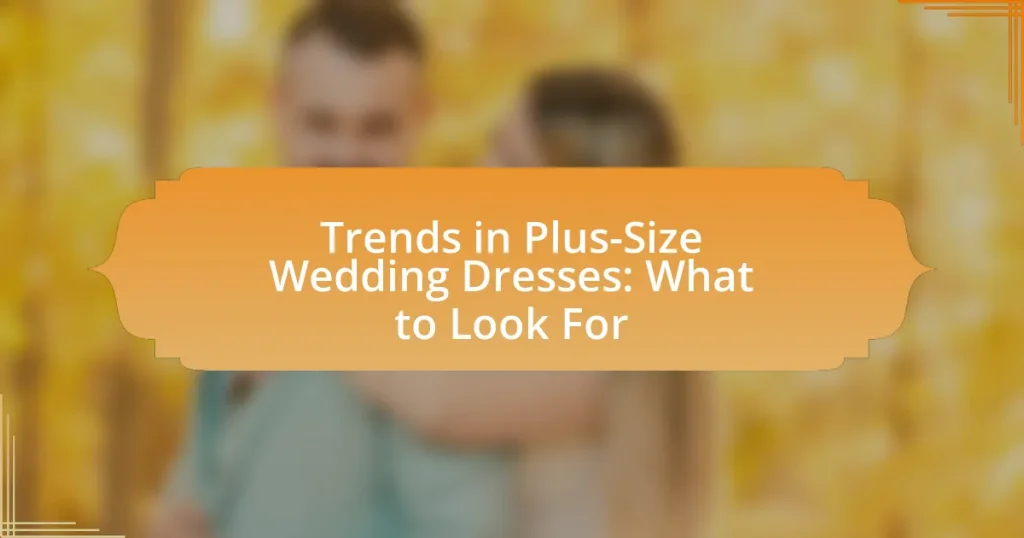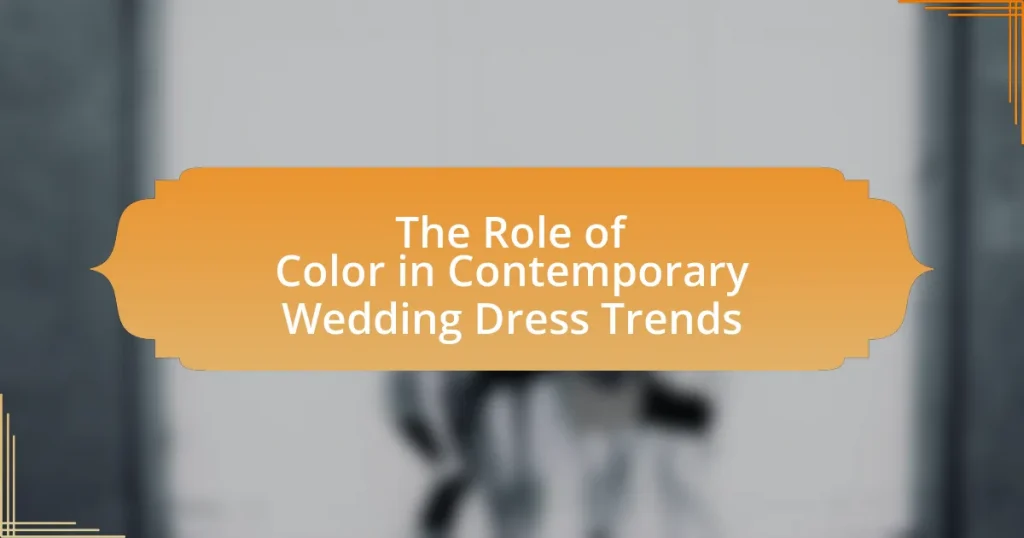Bridal jewelry encompasses the accessories worn by brides on their wedding day, including necklaces, earrings, bracelets, and hairpieces, which enhance the overall bridal look and symbolize the significance of the occasion. The article explores how bridal jewelry complements wedding dresses, popular styles, and the factors influencing jewelry selection, such as dress style, neckline, and wedding theme. It also discusses the materials commonly used in bridal jewelry, the importance of personal style, and practical tips for coordinating jewelry with a dress. Additionally, the article highlights common mistakes to avoid and best practices for ensuring comfort and wearability on the wedding day.
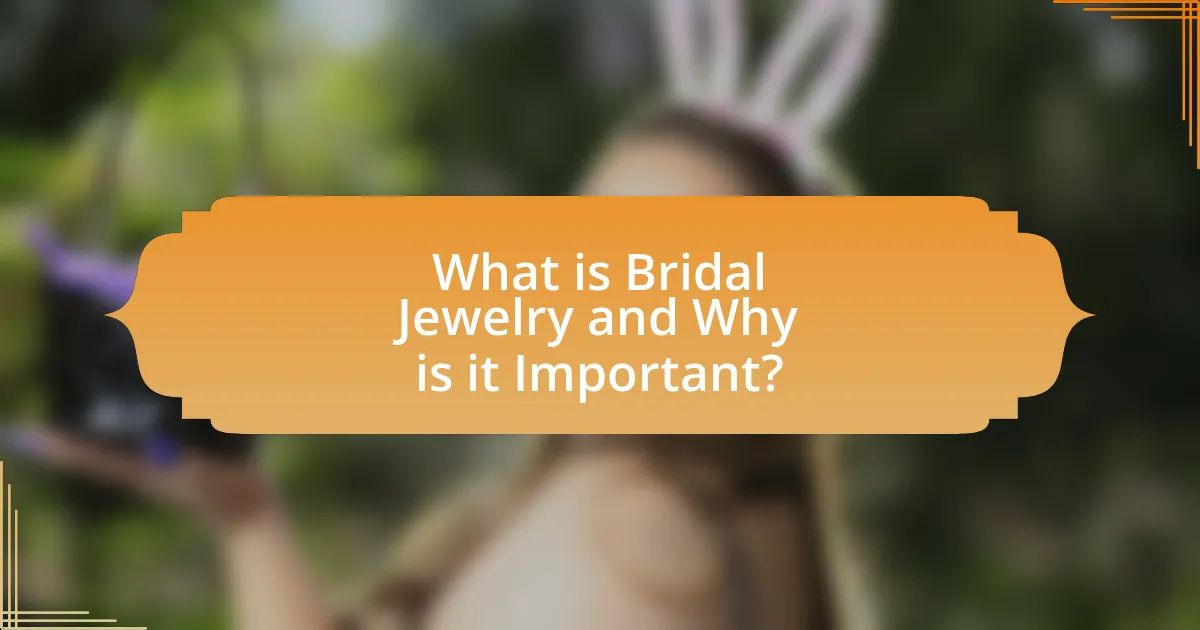
What is Bridal Jewelry and Why is it Important?
Bridal jewelry refers to the accessories worn by brides on their wedding day, including items such as necklaces, earrings, bracelets, and hairpieces. This type of jewelry is important because it enhances the overall bridal look, complements the wedding dress, and symbolizes the significance of the occasion. Historically, bridal jewelry has been used to signify wealth and status, with many cultures incorporating specific pieces that carry traditional meanings, such as the use of pearls for purity or diamonds for eternal love. The right bridal jewelry not only adds elegance but also serves as a personal expression of the bride’s style and identity on a momentous day.
How does Bridal Jewelry complement a wedding dress?
Bridal jewelry enhances a wedding dress by adding elegance and personal style, creating a cohesive look for the bride. The right pieces, such as necklaces, earrings, and bracelets, can accentuate the dress’s neckline, complement its fabric, and highlight the bride’s features. For example, a statement necklace can draw attention to a strapless gown, while delicate earrings can add a touch of sophistication without overwhelming the overall appearance. Studies in fashion design emphasize that accessories play a crucial role in completing an outfit, reinforcing the idea that bridal jewelry is essential for achieving a polished and harmonious bridal look.
What styles of bridal jewelry are most popular?
The most popular styles of bridal jewelry include classic diamond pieces, vintage-inspired designs, and modern minimalist styles. Classic diamond jewelry, such as solitaire earrings and tennis bracelets, remains a timeless choice for brides, often symbolizing elegance and tradition. Vintage-inspired jewelry, featuring intricate details and antique finishes, appeals to those seeking a romantic or nostalgic aesthetic. Modern minimalist styles, characterized by clean lines and understated elegance, cater to contemporary brides who prefer a sleek and sophisticated look. These trends reflect current bridal preferences and are frequently highlighted in bridal fashion publications and wedding planning resources.
How does the choice of jewelry reflect personal style?
The choice of jewelry reflects personal style by showcasing individual preferences, values, and aesthetics. Jewelry serves as a form of self-expression, allowing individuals to communicate their personality through design, material, and cultural significance. For instance, someone who prefers minimalist jewelry may value simplicity and elegance, while a person who chooses bold, statement pieces might embrace creativity and confidence. Additionally, the selection of jewelry can be influenced by cultural heritage, with specific designs or materials representing traditions and beliefs. This connection between jewelry and personal style is evident in bridal choices, where brides often select pieces that resonate with their identity and complement their wedding attire.
What factors should be considered when choosing bridal jewelry?
When choosing bridal jewelry, factors such as the wedding dress style, personal taste, and the overall wedding theme should be considered. The wedding dress style dictates the type of jewelry that complements it; for example, a vintage dress pairs well with antique-style pieces, while a modern gown may suit sleek, contemporary jewelry. Personal taste is crucial, as the bride should feel comfortable and confident in her choices, reflecting her unique style. Additionally, the overall wedding theme influences jewelry selection; a beach wedding may call for lighter, more casual pieces, while a formal event might require more elaborate and luxurious options. These considerations ensure that the bridal jewelry enhances the overall look and feel of the wedding day.
How do dress style and neckline influence jewelry selection?
Dress style and neckline significantly influence jewelry selection by determining the type and scale of accessories that complement the overall look. For instance, a strapless gown often pairs well with statement necklaces that draw attention to the neckline, while a high-neck dress may require simpler earrings to avoid overwhelming the outfit. Additionally, the fabric and embellishments of the dress can dictate whether to choose delicate or bold jewelry; intricate gowns may benefit from understated pieces, whereas simpler styles can handle more elaborate accessories. This approach ensures a harmonious balance between the dress and jewelry, enhancing the overall aesthetic without clashing.
What role does the wedding theme play in jewelry choices?
The wedding theme significantly influences jewelry choices by dictating the style, materials, and overall aesthetic of the pieces selected. For instance, a vintage-themed wedding may lead to the choice of antique or heirloom jewelry, while a modern, minimalist theme might favor sleek, contemporary designs. This alignment ensures that the jewelry complements the overall decor and attire, enhancing the cohesive look of the wedding. Additionally, specific themes often evoke particular colors or motifs, guiding brides to select jewelry that harmonizes with these elements, thereby reinforcing the intended atmosphere of the celebration.

What Types of Bridal Jewelry are Available?
Bridal jewelry includes various types such as necklaces, earrings, bracelets, and hair accessories. Necklaces can range from simple pendants to elaborate statement pieces, while earrings may include studs, hoops, or chandeliers. Bracelets often feature delicate chains or bangles, and hair accessories can consist of tiaras, combs, or pins adorned with crystals or pearls. Each type of jewelry complements the bridal gown and enhances the overall look, making it essential for brides to choose pieces that align with their personal style and wedding theme.
What are the different categories of bridal jewelry?
The different categories of bridal jewelry include necklaces, earrings, bracelets, and hair accessories. Necklaces can range from simple chains to elaborate statement pieces, while earrings may vary from studs to chandeliers. Bracelets often complement the overall look, and hair accessories, such as tiaras or hairpins, add elegance. Each category serves to enhance the bridal attire and is selected based on the wedding theme and personal style.
What are the key features of necklaces for brides?
Key features of necklaces for brides include elegance, personalization, and compatibility with the wedding dress. Elegance is often achieved through the use of high-quality materials such as pearls, diamonds, or gold, which enhance the overall bridal look. Personalization allows brides to choose designs that reflect their individual style, whether through custom pieces or meaningful symbols. Compatibility with the wedding dress is crucial; necklaces should complement the neckline and overall aesthetic of the gown, ensuring a harmonious appearance. For instance, a statement necklace may suit a strapless dress, while a delicate pendant might be ideal for a high-neck design.
How do earrings enhance a bridal look?
Earrings enhance a bridal look by adding elegance and completing the overall aesthetic of the ensemble. They draw attention to the bride’s face, framing it beautifully and complementing her hairstyle. For instance, statement earrings can serve as a focal point, elevating a simple dress, while delicate studs can add a touch of sophistication without overwhelming the look. Additionally, the choice of earrings can reflect the wedding theme; for example, vintage-inspired pieces can enhance a classic bridal gown, while modern designs can suit a contemporary style. This versatility in design and style reinforces the importance of earrings in achieving a cohesive and polished bridal appearance.
What materials are commonly used in bridal jewelry?
Common materials used in bridal jewelry include gold, silver, platinum, diamonds, pearls, and gemstones. Gold is favored for its durability and aesthetic appeal, while silver offers a more affordable option. Platinum is known for its strength and hypoallergenic properties, making it ideal for sensitive skin. Diamonds are often chosen for their brilliance and symbolism of eternal love, whereas pearls add a classic touch. Gemstones, such as sapphires and emeralds, are also popular for their vibrant colors and personal significance. These materials are widely recognized in the bridal jewelry industry for their beauty and significance in wedding traditions.
How do different metals affect the overall look?
Different metals significantly influence the overall look of bridal jewelry. For instance, yellow gold imparts a warm, classic appearance, often complementing traditional wedding dresses. In contrast, white gold or platinum offers a sleek, modern aesthetic that pairs well with contemporary styles. Rose gold introduces a romantic, vintage feel, enhancing soft, delicate designs. Additionally, the choice of metal can affect the perceived color of gemstones; for example, a diamond set in yellow gold may appear warmer than in white gold. This interplay between metal and design elements is crucial for achieving a cohesive bridal look.
What gemstones are popular for bridal jewelry and why?
Diamonds, sapphires, emeralds, and rubies are popular gemstones for bridal jewelry due to their beauty, durability, and symbolic meanings. Diamonds are favored for engagement rings because of their hardness and association with eternal love. Sapphires, often blue, symbolize fidelity and are increasingly chosen for engagement rings and wedding bands. Emeralds represent rebirth and love, making them a unique choice for brides seeking something different. Rubies, symbolizing passion and love, are also gaining popularity in bridal jewelry. Each gemstone’s significance and aesthetic appeal contribute to their popularity in bridal jewelry.
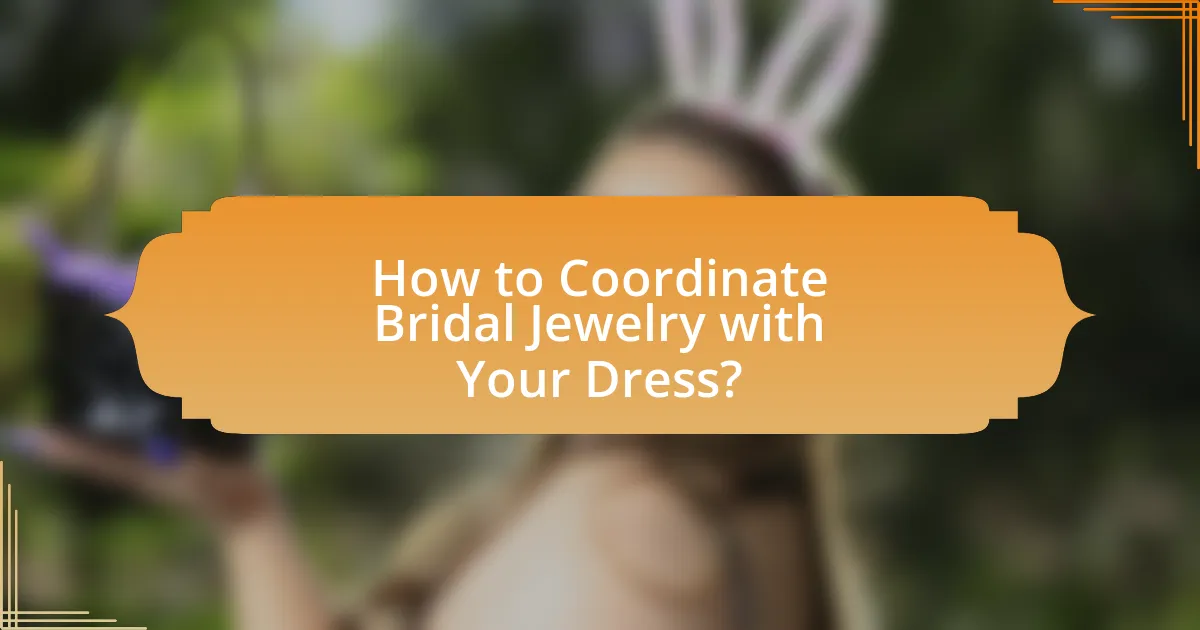
How to Coordinate Bridal Jewelry with Your Dress?
To coordinate bridal jewelry with your dress, first identify the style and color of your gown. For instance, if your dress is a classic white ball gown, opt for silver or pearl jewelry to complement its elegance. Conversely, if your dress features intricate beading or a bold color, choose simpler jewelry to avoid overwhelming the look. Additionally, consider the neckline of your dress; a strapless gown pairs well with statement necklaces, while a high neckline may require stud earrings or a delicate bracelet. This approach ensures a harmonious balance between your jewelry and dress, enhancing your overall bridal aesthetic.
What tips can help in matching jewelry with a wedding dress?
To effectively match jewelry with a wedding dress, consider the dress’s style, neckline, and embellishments. For instance, if the dress has a detailed neckline, opt for simpler jewelry to avoid overwhelming the look. Conversely, a minimalist dress can be complemented with statement pieces. Additionally, the metal of the jewelry should harmonize with the dress’s fabric; for example, gold jewelry pairs well with warm-toned fabrics, while silver suits cooler tones. Finally, ensure that the jewelry reflects the overall theme of the wedding, whether it’s classic, bohemian, or modern, to create a cohesive appearance.
How can color schemes influence jewelry choices?
Color schemes significantly influence jewelry choices by guiding the selection of pieces that complement or contrast with the colors of the bridal attire. For instance, a wedding dress with a warm color palette, such as ivory or champagne, typically pairs well with gold or rose gold jewelry, enhancing the overall warmth of the look. Conversely, a dress in cooler tones, like silver or white, often aligns better with silver or platinum jewelry, creating a harmonious aesthetic. Research indicates that color theory plays a crucial role in fashion, where complementary colors enhance visual appeal and create a cohesive style. Therefore, understanding the color scheme of the bridal outfit is essential for making informed jewelry choices that elevate the overall appearance.
What are the best practices for layering jewelry?
The best practices for layering jewelry include selecting pieces of varying lengths, mixing different textures and materials, and balancing statement pieces with more delicate items. Choosing necklaces of different lengths creates visual interest and prevents tangling, while combining metals like gold and silver adds depth to the look. Additionally, pairing bold earrings with subtle necklaces ensures that the overall appearance remains harmonious. These practices enhance the aesthetic appeal of layered jewelry, making it suitable for occasions such as weddings, where a balanced and elegant look is essential.
What common mistakes should be avoided when selecting bridal jewelry?
Common mistakes to avoid when selecting bridal jewelry include choosing pieces that clash with the wedding dress, neglecting to consider the overall wedding theme, and failing to prioritize comfort. Selecting jewelry that does not complement the dress can create a disjointed look; for example, pairing ornate jewelry with a simple gown can overwhelm the outfit. Additionally, ignoring the wedding theme may lead to mismatched styles, such as wearing vintage jewelry for a modern wedding. Lastly, prioritizing aesthetics over comfort can result in distractions during the ceremony, as uncomfortable pieces may hinder movement or cause irritation.
How can over-accessorizing detract from the bridal look?
Over-accessorizing can detract from the bridal look by overwhelming the overall aesthetic and drawing attention away from the bride herself. When a bride wears too many accessories, such as excessive jewelry, it can create a cluttered appearance that competes with the wedding dress, which should be the focal point. This is supported by fashion principles that emphasize balance and harmony in styling; for instance, the rule of thumb in fashion suggests that less is often more, allowing key pieces to shine without distraction.
What should brides consider about comfort and wearability?
Brides should prioritize the fit and fabric of their wedding attire to ensure comfort and wearability. A well-fitted dress allows for ease of movement, which is essential for activities such as dancing and walking. Additionally, lightweight and breathable fabrics, such as chiffon or silk, enhance comfort, especially during long events. Research indicates that 70% of brides report discomfort as a significant factor affecting their overall wedding experience, highlighting the importance of choosing attire that balances style with practicality.
What are some practical tips for choosing bridal jewelry?
When choosing bridal jewelry, prioritize harmony with your wedding dress style. For example, if your dress is intricate, opt for simpler jewelry to avoid overwhelming the look. Additionally, consider the neckline of your dress; a strapless gown pairs well with statement necklaces, while a high neckline may require stud earrings or a delicate bracelet.
Furthermore, select materials that complement your dress fabric; for instance, pearls work beautifully with lace, while diamonds suit satin. Ensure the jewelry fits comfortably, as you will wear it for an extended period. Lastly, keep your personal style in mind to ensure the jewelry reflects your personality, enhancing your overall bridal look.
How can brides ensure their jewelry complements their dress on the big day?
Brides can ensure their jewelry complements their dress by selecting pieces that match the style, color, and neckline of their gown. For instance, if a bride wears a strapless dress, statement earrings or a bold necklace can enhance the look, while a dress with intricate detailing may require simpler jewelry to avoid overwhelming the outfit. Additionally, considering the metal tones of the dress—such as gold, silver, or rose gold—can help in choosing complementary jewelry. Research indicates that color coordination and style matching significantly impact overall aesthetic appeal, reinforcing the importance of thoughtful selection in bridal accessories.
What are the best ways to care for bridal jewelry before and after the wedding?
The best ways to care for bridal jewelry before and after the wedding include proper storage, regular cleaning, and avoiding exposure to harsh chemicals. Storing bridal jewelry in a soft pouch or a dedicated jewelry box prevents scratches and tangling, while cleaning with a gentle solution, such as mild soap and water, maintains its shine. Additionally, keeping jewelry away from perfumes, lotions, and chlorine helps preserve its integrity. These practices are essential as they protect the jewelry’s appearance and longevity, ensuring it remains in excellent condition for future wear.
